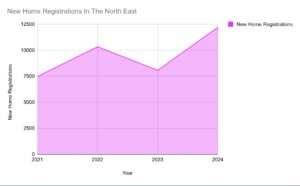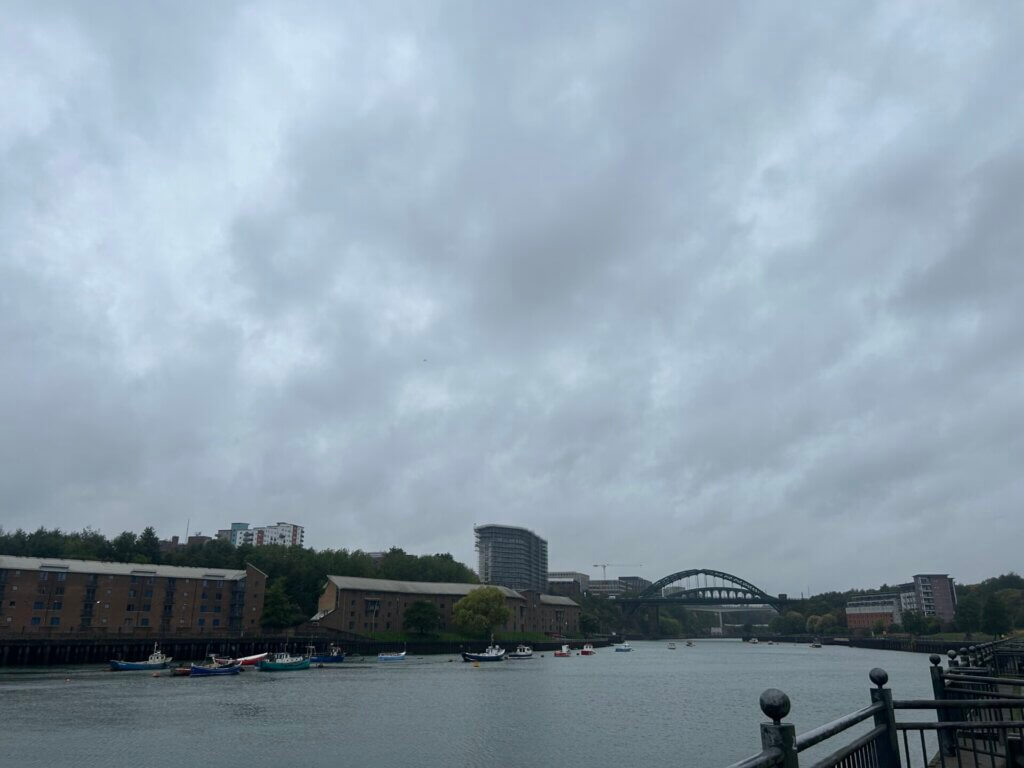Buzz Off: An inquiry into the North East’s pollinator crisis
Written by Kaitlyn Ashby on 12th May 2025
Pollinators in the North East are in trouble. According to the Natural History Society of Northumbria, species like bees, butterflies, and moths have seen worrying declines with some bumblebee populations down by 96% since 2008. As World Bee Day approaches on 20 May, attention is turning to the pressures driving this crisis: habitat loss, pesticides, and the relentless demand for land.
Picture this, it’s a beautiful, sunny spring morning in mid-April. You are buzzing because it’s not too hot, and it’s not too cold. You swoosh by some flowers on your way to work, and see a cabbage butterfly soaking up some sweet nectar and appreciate the vibrant patchwork of flowers and greenery that you get to call home.
All is as it should be, when all of a sudden, a humongous iron claw comes from up above and grabs a fistfull of the earth, tearing and dragging the flowers and butterfly with it; roots dangling down like a fairytale-maiden’s locks. Your neighbours, awoken by the sound of destruction, all crawl out to the sight of their homes being detonated by super-sized mechanical monsters.
Horrified, you fly after your buzzing colony to escape the detonation of your little village, and as the stench of diesel fills your lungs, somehow in this moment you feel lucky to have been born with wings, as you watch friends and acquaintances alike stagger on foot beneath you…
Except, that likely has not happened to you, because you are not a bee, a butterfly, or an insect of any kind, lucky for you.

(New Build construction in Stockton-on-Tees: my own image)
In 2024, the Natural History Society of Northumbria (NHSN) observed a significant decline in pollinating species like bees, moths and butterflies. Data from the Bumblebees Conservation Trusts Beewalk scheme revealed that since 2008, the combined population of bumblebee and red-tailed bees have plummeted by 96% and there is no clear reason as to what is to blame.
So, with the rise in homes being built and the decline in population of key pollinators, could there be at least one concrete point of blame?
I have created a simple graph below to depict the number of new home registrations across the Northeast of England from 2021-2024, according to the Office Of National Statistics (ONS).

Data revealing the amount of new home registrations there was between 2021 and 2024
These homes have been built on a mixture of land types. There are:
- Brownfield land: land that was previously occupied by permanent infrastructure.
- Greenfield land: land that has never been developed.
- Green belt land: designated land that protects the countryside.
To weigh in on the matter, I spoke to Julie from Newcastle District BeeKeepers Association, she said: “The destruction of habitat is a concern for all pollinators, so, the removal of hedgerows and trees to construct new builds are of concern because this is rarely replaced at the same rate, and when it is replaced, no thought has been given to make the planting pollinator-friendly.
Julie goes on: “Lack of pollinator planting such as plastic grass, use of organophosphates (weed killers) and loss of habitat are major concerns. Neonicotinoids have finally been banned for use on crops by the government this year after many years of campaigning; this has been a major worry for beekeepers as it does not just affect honey bees, but many other insect species that rely on these, for example, rapeseed.”
From Julie’s insights, it seems a larger problem is not building on green spaces, but rather the lack of ecosystemic rejuvenation. She told me: “Contrary to popular belief, honey bees are not a threatened species, solitary bees are under threat, though…In modern living, many people either don’t know what to plant or don’t have time to plant. Overpopulation of honey bees in some cities (eg, London) has been recognised as unsustainable; there are not enough food sources for them and they are out-competing some species.”
Julie is an expert, however, it arguably doesn’t take an expert to note that as cities grow, there is an increasing demand for more housing. Housing that is built better, insulated better and designed better, which sometimes means expanding into greenfield land. Places like Middlesbrough, Newcastle, Sunderland and Durham have seen a significant increase in residential housing development on this land-type which could be a contributing force in the decline of pollinators.
I also spoke with Pamela Chambers, founder of Bee Responsible, who took me right back to WW2 to pinpoint the start of the threat against England’s native pollinators, she believes:
- Since WW2, the demand for land has increased: “Established woodlands, wetlands, grasslands, wildflower meadows and ‘resting’ arable fields were sold off and now protected ‘greenbelt’ land is under review…”
- The human-caused destruction of natural habitats: “some species of insects, moths, bees (including solitary, bumble and honeybees), bats and birds have had their natural habitats destroyed in order to accommodate the demand for property. Established trees have been felled, grassy banks leveled, hedgerows uprooted and destroyed, natural ponds and water springs filled in and indigenous, native plants replaced by non-native shrubs that do not provide adequate food, water or shelter to the pollinators and mammals of this country, that are a crucial and important part of the food chain.”
- Intensive farming and machinery: “Bigger fields that make it harder for bees and insects to fly from their habitats to a source of nectar and cereal crops that are primarily grown in the UK are pollinated by the wind and do not sustain the food chain, as beneficial crops and wildflower meadows did in the past. Since WW2, Wildflower meadows in the UK have reduced by 98%. This means that pollinating insects are having to work a lot harder to find food, shelter and water to stay alive.”
- A lack of accessible water: “Many new-builds have systems built into the fabric of the building and roofs to conserve water. Whilst this is a great idea, it does not provide a water source for passing insects, birds or wildlife and so we at Bee Responsible Beehive Management Services actively encourage our clients to provide a ‘wildlife pond’ or water feature that animals of all kinds can drink from; particularly on industrial or commercial sites where concrete platforms and drainage systems do not compare to slow draining natural lawns.”
- Chemicals and pesticides: “It is not just the farming community that uses chemical sprays to protect young crops and harvest yields but also enthusiastic gardeners. Using Glyphosate based chemical sprays to keep weeds and pests under control, introduces chemicals into the plants, soil, water drainage, rivers and the wider environment. It has also been proved without doubt, that many of the agricultural and home-use plant and pest control chemicals are also poisoning our bees and wildlife.’
- Climate change: “Honeybees have been on this planet for over 100 million years and have adapted and evolved to work alongside the weather as it gradually changed and adapted to the planet. However, with the extreme changes in the weather patterns in the UK alone, the bees struggle to adapt to the temperatures and conditions, which causes stress. When bees are stressed, they are more susceptible to disease.”
She goes on: “There is also an argument that I support, that bee colony losses may also be due to our increased use of mobile phones and internet that is interrupting and compromising the electromagnetic field (EMF) that bees (birds, mammals and fish) use for navigation. With the increase in new build estates that include cabling and updated communication networks, wildlife living nearby new estates may be affected.”
Pamela’s invaluable insights highlight that there are several battles to face when it comes to protecting pollinators in this country, and listed a number of ways members of society can help out in the fight against their extinction. They are as follows:
- “Plant up beneficial plants, bulbs, shrubs, herbs, trees, vegetables etc that feed bees and wildlife in containers, plant pots, gardens, managed landscapes etc.
- Leave areas of the garden ‘unattended’ and provide wildlife corners to encourage solitary bees to set up habitats.
- Provide a wildlife pond or water feature to hydrate wildlife
- Limit the use of chemicals in managing pests
- Set up a community garden or allotment and fill with beneficial plants
- Support ‘No Mow May’ and encourage Clover, Daisies, Dandelions to grow in lawns and reduce mowing schedules throughout the summer, retaining water and feeding insects
- Install bee and bug hotels
- Use wildflower bombs in and around the garden
- Lobby local councils, the Government and property developers to action the above and honour their Biodiversity Net Gain (BNG)/ Corporate Social Responsibility (CSR)/ Net Zero, Green Initiatives and Environmental Policies rather than just give ‘lip service’ or ‘green-wash’ policies as a tick box exercise
- Encourage developers and garden/ landscape architects to design estates with an emphasis on supporting wildlife and the food chain.
- Support agronomists, ecologists and conservation
- Support local beekeepers and buy local honey direct from them – support your local producers
- Educate the next generation about the importance of pollinators, bees and their relationship to our food and biosecurity and to the ongoing health of our environment and our planet
The data speaks for itself. Experts like Pamela and Julie highlight the urgency to protect pollinators and ecosystems through restoration, a reduction in the use of pesticides and more eco-conscious development.
Pamela added: “After all, without the pollinating services of pollinators, two thirds of the planet’s food would be gone. Without the pollinating services of bees alone, a third of the food available to humans and animals would disappear. Food for thought, don’t you think?”
As society continues its rapid expansion and growth, the fight pollinators face does too. It is a fight for survival, a survival that evidently hangs in the balance. In order to ensure future generations continue to fear the buzz of a bee, and melt at the sight of the first butterfly after a cold winter, we as a society must take responsibility and do our part to preserve such a fundamental part of our everyday lives. Not just for their survival, but ultimately, ours.







